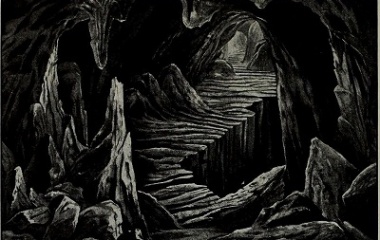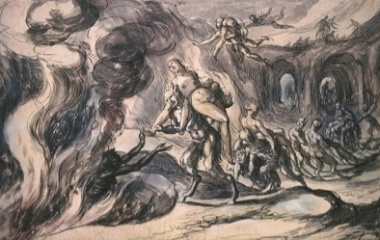After we die, we may be lucky enough to be swept up to an eternal paradise to dwell with the gods. Alternately, for those that have lived an immoral life, something far worse may be in store. An eternal, raging fire will burn away our sins or we will suffer for eternity in gruesome, dark, upside down torment and be made to eat excrement in a place known in many religions as hell.
What Is Hell?
Hell is a destination for the soul after death. Across numerous religions, the meaning of hell differs from an actual location to a state and from being a state of permanence to a phase in the enlightenment of the soul. Scholars believe the etymology of the word hell is from the Old English hel, which means to conceal or cover. The word’s meaning can be confusing though, as it has also been used as the English version of Sheol and Gehenna, as well as to refer to Hades and Tartarus in Greek mythology.
In Christianity
Within the Christian faith, the term refers to a place of punishment in the afterlife. Authors relay the different meanings of hell portrayed in the New Testament and highlight the confusion of whether sinners go to hell for a short period of time or for eternity. It is also not clear whether hell begins only after the final judgement or immediately after the sinner dies. The most commonly held belief in Christianity is that the soul will receive punishment in hell equal to the sins it has committed. Seventh Day Adventists believe that the soul remains with the body until the resurrection and judgement. Jehovah’s Witnesses purport there is no afterlife and the soul no longer exists after death. The location of hell is alleged to be in the center of the Earth or perhaps in the upper atmosphere, according to various sources.
In Buddhism
In Buddhist beliefs there are different levels of afterlife a soul is sent to after death. The levels are, however, not a permanent state, and a person can be reborn into another state. If a person does not commit good deeds in life, he or she may be sent to the hungry ghost level, or hell beings level, and endure considerable suffering.
In Hinduism
Similar to Buddhism, Hindu practitioners believe in the cycle of rebirth. Those that have lived a life of bad karma are sent to a level called hell. Various levels of hell developed with the evolution of Hinduism, entailing different degrees of suffering and pain for perpetrators. Ultimately, practitioners want to transcend the endless cycle of death and rebirth and be born into a state of nirvana.
In Judaism
Sheol is the name of hell or the afterlife in the Hebrew bible. Souls arrive there after death, whether they have been sinful or not. God selects the worthy out of the dark and silent abode of hell and reunites them with their ancestors. The idea of an eternal punishment, as well as the restorative function of hell, are mentioned in Jewish sources.
In Islam
Jahannam is the term for hell in Islam. It refers to the place souls will be sent after the final judgement, if they are not worthy of paradise. Scholars acquaint us with a story of a bridge souls need to cross as a test. If the soul is righteous, they will be able to cross the bridge, but if not, the bridge becomes too narrow and the sinners fall down into hell. The sinners who are believers will not be punished indefinitely, but the non-believers will have no redemption and will live on pus and bitter fruit in hell for eternity.
In Zoroastrianism
In the ancient religion of Zoroaster, hell is viewed as cold, dark and hostile and is ruled over by Yima, who ensures the torture of sinners. Followers believed hell would be destroyed with the return of their prophet, Ahura Mazdā. Before the resurrection, however, souls must cross over a bridge where they may pass into heaven or fall down into hell, similar to Islamic beliefs.
In Egypt
During the Middle Kingdom period, the cult of Osiris judged its followers after death by their morality. If they had lived a righteous life, they were sent to be united with the gods in a blissful eternity. The soul had to undergo many trials during the judgement process, however. The most important was the weighing of the heart against a feather. The feather represented Ma’at, the order and ethical nature of the universe. If the person’s heart was heavier than the feather, they would be devoured by a beast with a crocodile’s head – known as Ammit – and have their existence completely erased. Other sources cite a different version of hell, where souls drank and ate excrement and lived in darkness in an inverted world.
In Mesopotamia
In ancient Mesopotamian mythology, hell is viewed as an eternal place after death that one cannot escape from. In a poem called the Descent of Inanna, a Sumerian goddess of love and fertility decides to pay a visit to her sister, the ruler of the underworld, after the death of her sister’s husband. As she reaches her sibling’s domain, however, she soon realizes her sister is not pleased to see her, as she locks all seven of the underworld gates. In order for Inanna to proceed through each gate, she must remove a piece of her resplendent attire. Eventually she has removed her crown, golden armor, scepter, and all her clothing, and stands naked in her sister’s court, where she is judged and turned into a corpse!
In Greek Mythology
The Greek underworld, known as Hades, was a dark place guarded at its gates by a vicious three-headed dog. Souls were judged for their actions and sent to drink from the Lethe River and on to the Elysian Fields, if they were honorable. If they were immoral, they were sent to Tartarus, where some of the extreme punishments of the gods included an eternity of trying to roll a massive rock uphill, plaiting one end of a rope while a donkey chewed on the other end, or being fixed to a wheel which kept spinning.
Dante’s Hell
In Dante’s Divine Comedy, he describes hell as having nine levels and being located inside the Earth. According to Dante, the devil resides in the center, trapped in ice and with three faces. It is a place of severe suffering and sports a sign at its entrance which reads: Abandon all hope, ye who enter here.
Indeed, hell is understood, in many religions, as a place devoid of hope and full of eternal suffering. It is also viewed, however, as a state of purification or a stage of spiritual growth, in polytheistic religions largely. If we are able to improve ourselves and become more god-like with each lesson learned, is it not only fair to provide us with a chance to reach paradise and commune with the gods, rather than being plunged into hell?










